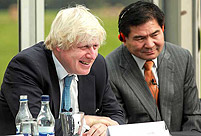WASHINGTON, Oct. 17 -- The U.S. government will end its partial shutdown after President Barack Obama signed a last-minute deal early Thursday to reopen the federal government and raise the debt ceiling.
Obama signed the bill into law without further comment after both the House and Senate approved it late Wednesday.
Speaking shortly after the Senate vote, the president said he would sign the bill as soon as it came to his desk and the process of reopening government would begin "immediately."
He thanked leaders from both the Democrats and the Republicans for working out an agreement to end the government shutdown and raise the debt ceiling.
"Hopefully next time it won't be in the 11th hour," he said. "We've got to get out of the habit of governing by crisis."
Minutes after Obama signed the bill, White House budget director Sylvia Mathews Burwell issued a directive to employees, saying the government would try and make the transition back to fully operational as smooth as possible.
"All employees who were on furlough due to the absence of appropriations may now return to work. You should reopen offices in a prompt and orderly manner," she said.
"This has been a particularly challenging time for Federal employees and I want to thank our Nation's dedicated civil servants for their continued commitment to serving the American people," Burwell added.
She said most of the employees who had been furloughed for the past two weeks were expected to get back to work Thursday.
Earlier Wednesday night, the U.S. House of Representatives approved the bill shortly after the Senate passed it, clearing the final hurdles for the country to return from the brink of an historic debt default.
The Republican-controlled House voted 285-144 in favor of the bill, which funds the government through to Jan. 15 and raises the debt ceiling until Feb. 7.
Early Wednesday night, the Democratic-led Senate, with a 81-18 vote, approved the measure, which emerged as Senate Majority Leader Harry Reid and Minority Leader Mitch McConnell announced the bipartisan compromise.
The bill ended weeks of tension and stalemate between the two parties, which had lurched the federal government into the first partial shutdown in 17 years and pushed the country very close to default.
The debt limit is the total amount of money that the U.S. government is authorized to borrow to meet its existing legal obligations, which include Social Security and Medicare benefits, military paychecks, interest on the national debt, and others.
The U.S. government reached its statutory debt limit of about 16.7 trillion U.S. dollars on May 19. Since then, the Treasury has been using what it termed "extraordinary measures" to raise funds and pay government bills.
The Treasury estimated that it would exhaust those measures on Thursday, with merely 30 billion dollars cash on hand, whereas its daily payments can run to 60 billion.
The deal staved off a default, but is a short-term fix rather than a final, long-term solution. It does not erase the fundamental gaps between the Republicans and Democrats' stances on spending and deficits.
The 2010 healthcare law, commonly known as Obamacare, was kept practically intact under the deal. The Republicans had forced the stalemate by demanding to link the spending measure to changes or delays in Obamacare. However, the party has not given up the battle.
House Speaker John Boehner said Wednesday afternoon that they would not block the bipartisan agreement reached in the Senate, but would continue their fight against Obamacare.
"Our drive to stop the train wreck that is the president's healthcare law will continue," he said in a statement.
Some lawmakers argued that Obamacare is unaffordable and unsustainable and called for a repeal, fearing that it could add debt when the country is already around 17 trillion dollars in the red.
 No news of survivors in Lao Airlines crash
No news of survivors in Lao Airlines crash China's destroyer Qingdao sails out of Sydney Harbor
China's destroyer Qingdao sails out of Sydney Harbor Chinese tycoon aims to restore London's Crystal Palace
Chinese tycoon aims to restore London's Crystal Palace Admirers to bid joyful goodbye to Rubber Duck
Admirers to bid joyful goodbye to Rubber Duck Photo story: For the last three students
Photo story: For the last three students  Photo story: A day in the life of a car model
Photo story: A day in the life of a car model Chinese screen goddesses from Beijing Film Academy
Chinese screen goddesses from Beijing Film Academy  Weekly Sports Photos
Weekly Sports Photos World's most amazing yacht on display in Guangzhou
World's most amazing yacht on display in Guangzhou Photo collection of Chinese Navy
Photo collection of Chinese Navy Cold air sweeps through N China
Cold air sweeps through N China The last family in shantytowns
The last family in shantytowns UNESCO world heritage site: Montale Tower
UNESCO world heritage site: Montale Tower U.S. Senate leader announces bipartisan deal
U.S. Senate leader announces bipartisan deal Fiber-optic wedding dress show shinning in Suzhou
Fiber-optic wedding dress show shinning in Suzhou Day|Week|Month